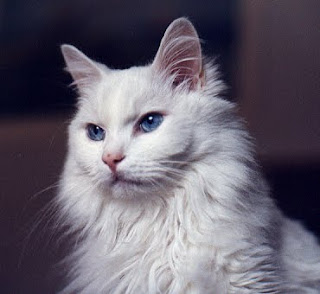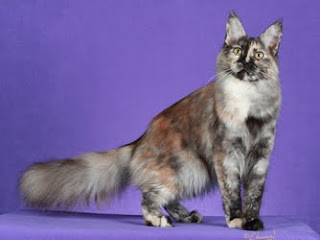
Turkish Angora
Turkish Angora cat, including agility, like moving and very friendly towards other cats. Turkish Angora also like to ask the attention of employers and manja.Kucing Turkish Angora is known as a very intelligent cat, curiosity about something pretty big. Turkish angora cat is too funny, very adaptable and easy to get along with the occupants of the house. Angora cat race has a body size of medium, with a gracefulness and elegance. Body long, slender, with long legs and tail. Thick furry tail and fluffy like a fox tail. Most white Turkish Angora, lilac, and dark brown. Turkish Angora cat, do not have two layers of fur, like Persian cats. So that kind of cat is easier to comb. Turkish Angora small bodied long but muscular and thick. Turkish Angora has a wide shoulder and buttocks as much. But his butt is higher than his shoulder, because the hind legs longer than front legs. Turkish Angora aquiline nose, the whole head is shaped like a triangle, with the width and pointed ears, big eyes almond shaped. This cat colors vary, some are white, black, brown, Tricolour / blangtelon (white, black, brownish yellow), yellow, reddish, etc.. Turkish Angora cats are hunters and have a nature hunt like to be invited, and love to play water, must also have a lot of free time to move.
- Health considerations
In the Turkish Angora, a disease commonly That Is Referred to as ataxia, is found. Ataxia is thought to be inherited as autosomal recessive. The kittens affected by ataxia have Parkinson's like movements, and require intensive nursing care to help Them survive. These kittens are usually euthanized, but there are reports of a small handful of kittens That may have survived to Adulthood. The genetic cause of this ataxia is not yet known. Another genetic illness known to the breed is Hypertrophic Cardiomyopathy, the which is a cardiac condition usually found the between the ages of 2-6, with males being affected more commonly and more severely than females.
In the Maine Coon cat, HCM is thought to be an autosomal dominant gene, and Researchers are working to identify markers for this disease. However, in the Turkish Angora, the disease has not yet been studied at length, and is Likely to result from a different mutation of genes, with a different gene location than That of the Maine Coon cat. HCM also affects many other breeds (from Ragdolls to Persians, to the Bengals).
source health Turkish Agora









No comments:
Post a Comment